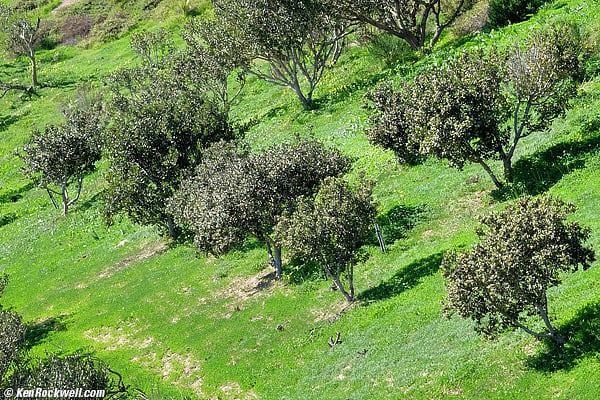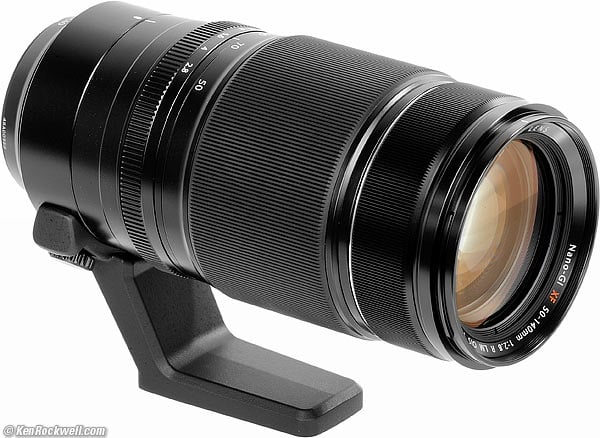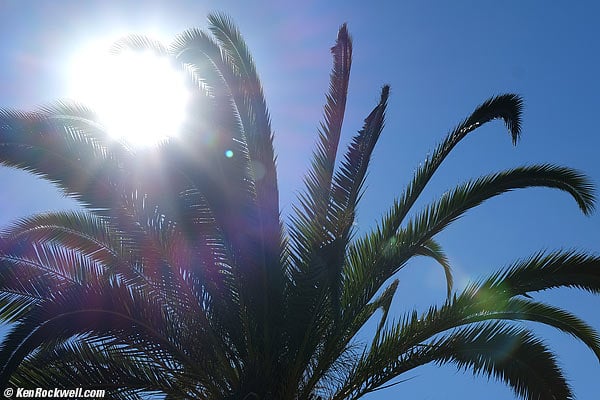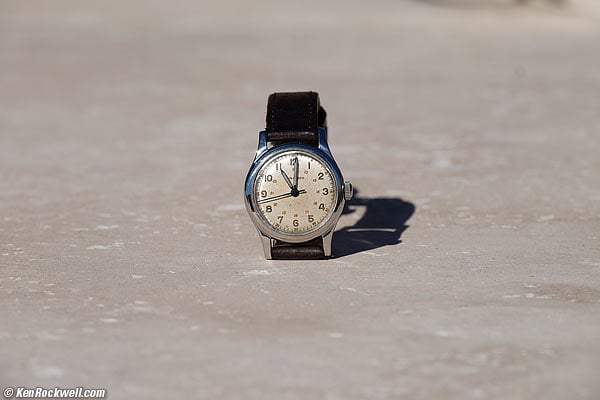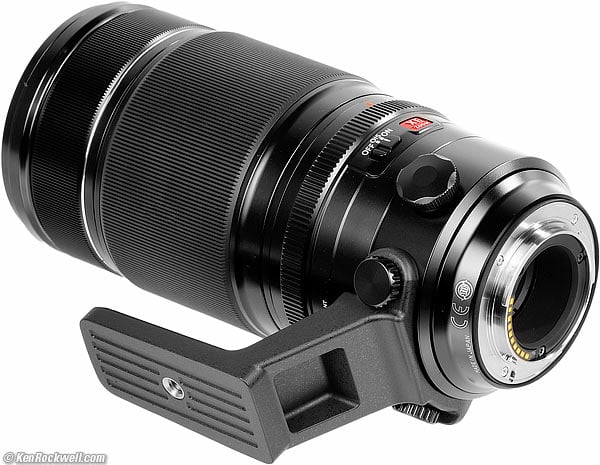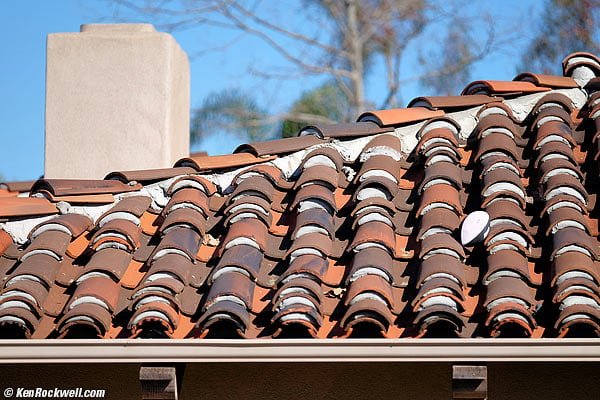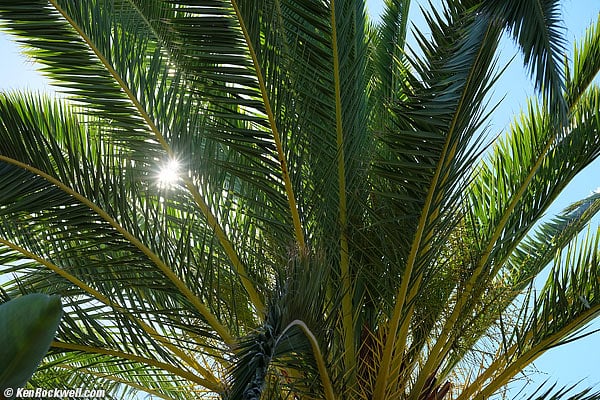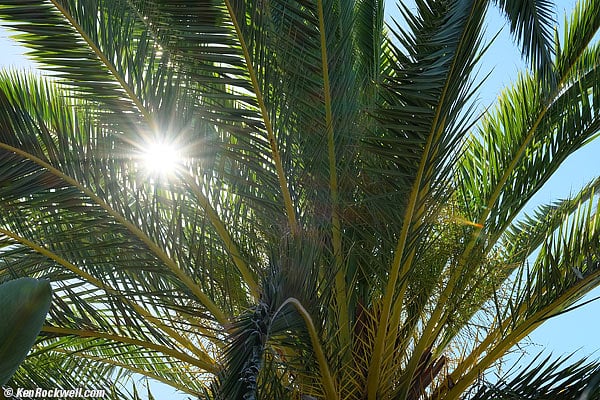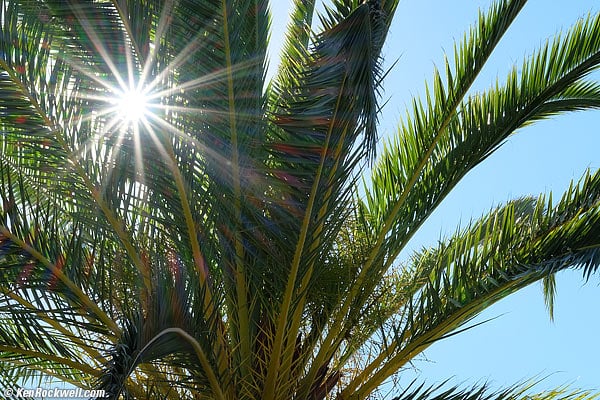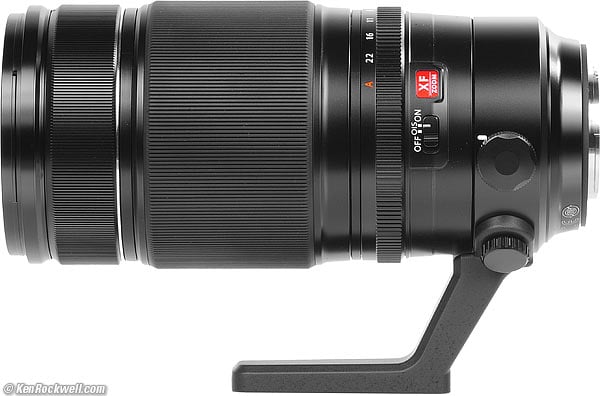Home Donate New Search Gallery Reviews How-To Books Links Workshops About Contact
Fuji 50-140mm f/2.8
Stabilized and Weather-Resistant
(2014-, 75-210mm equiv.)
© 2015 KenRockwell.com. This page best with Corporate S regular and bold activated.
Intro Specs Performance Usage Recommendations More
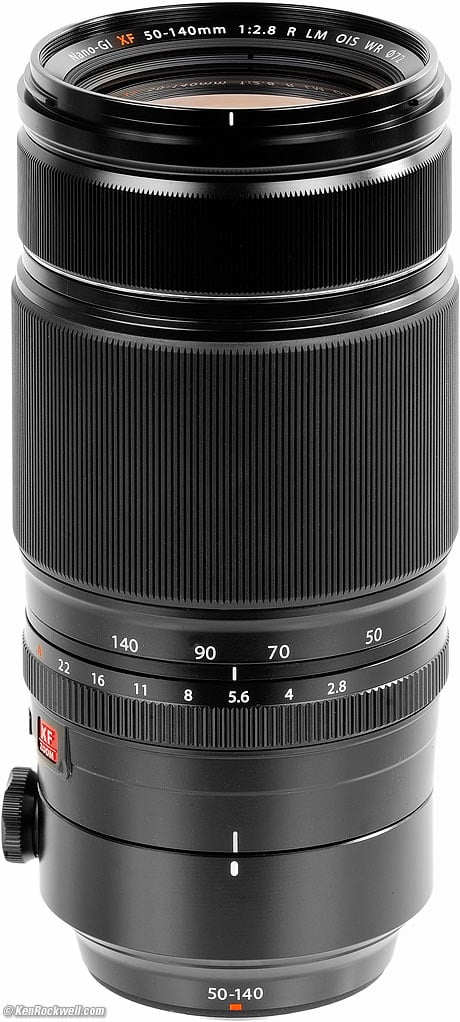
Fujinon XF 50-140mm f/2.8 OIS WR for X-mount cameras (metal 72mm filter thread, 38.6 oz./1,093g with foot, 34.8 oz./987g lens only, 3'/1m close focus, about $1,599). I got mine at this link to it at Adorama; these links to it at Amazon and at B&H are also great places to get it.
This all-content, junk-free website's biggest source of support is when you use those or any of these links to approved sources when you get anything, regardless of the country in which you live. Fuji does not seal its boxes, so never buy at retail or any source not on my personally approved list since you'll have no way of knowing if you're missing accessories, getting a defective or damaged customer return, a store demo or a used lens. Buy only from the approved sources I use myself for the best prices, service, return policies and selection. Thanks for helping me help you! Ken.
January 2015 Fuji Reviews Fuji X-Mount Lenses LEICA Reviews All Reviews
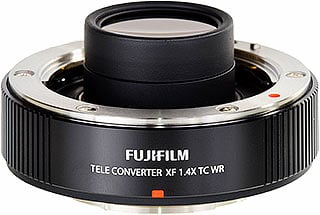 NEW: Fuji 1.4x Teleconverter 10 June 2016
NEW: Fuji 1.4x Teleconverter 10 June 2016
Sample Image Files (more throughout the review)
Pineapple, 15 January 2015. Fuji X-E2, Fuji 50-140mm at 56mm, f/8 at 1/50 hand-held at Auto ISO 200, Athentech Perfectly Clear V2. Full-resolution.
Weed Vineyard, 15 January 2015. Fuji X-E2 at ISO 200, 50-140mm at 140mm wide-open at f/2.8 at 1/850, Athentech Perfectly Clear. Unprocessed camera-original JPG.
Introduction top
Intro Specs Performance Usage Recommendations More
This Fuji XF 50-140mm OIS WR is a fast and optically near-perfect telephoto lens. It's image-stabilized (OIR) and weather-resistant (WR).
It's a solid bar of precision that feels great to use. Zoom and focus are internal, so nothing moves externally.
It's probably the only f/2.8 telephoto zoom made for an APS-C camera, and this Fujinon is made out of metal, not plastic.
This Fuji telephoto stands out not only for its superior mechanical quality and extreme sharpness, but also for its complete lack of any visible distortion, lateral color fringes or light falloff.
The only gotcha with this Fuji lens, like all of them, is that while autofocus is very good, manual focus is nowhere near as good as a DSLR lens. There is no mechanical manual focus; it's electronic, and manual override requires some menu fiddling and camera firmware updating to activate (turn on AF+MF deep in the camera menus). Manual focus is always very precise, but slow.
Image stabilization works great; all my shots at 1/15 at 140mm are sharp and it should work much slower, too.
The Fuji X-Mount Lenses are all extraordinary. What most photographers don't realize is that Fuji has for many decades, just like Canon and Nikon, also made far more advanced optics, like binoculars for the military and for use in space, as well as lenses for motion pictures and television with six-figure price tags at discount. Unlike mud brands like Sigma and Tamron (or even LEICA), Fujinon has loads of experience actually supplying optics that cost more than some people's houses, and puts that same know-how into these lenses.
This is a Fuji X-mount XF lens that works only on Fuji X-mount cameras.
Fuji XF 50-140mm OIS WR. bigger.
Specifications top
Intro Specs Performance Usage Recommendations More
Name
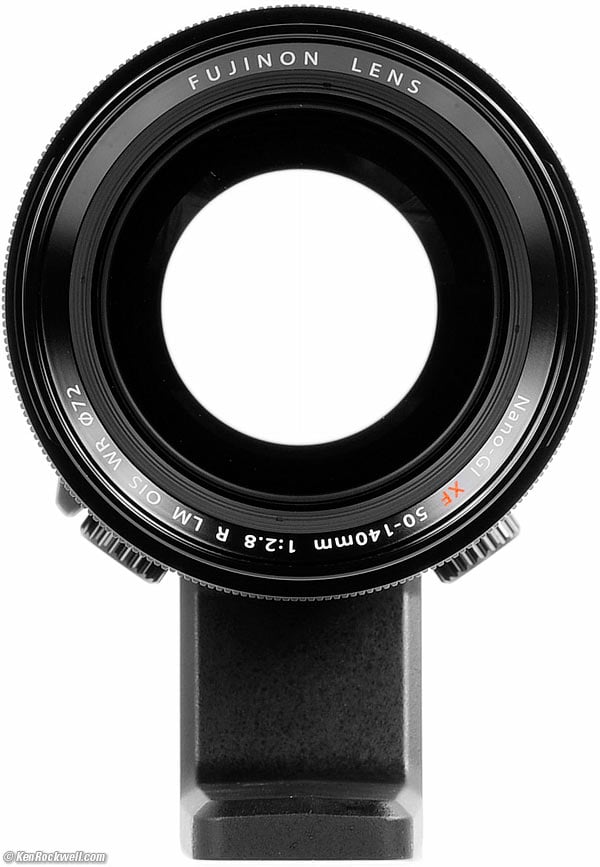
Fuji 50-140 OIS at 140mm at f/2.8.
Fuji calls this the Fujinon Nano-GI XF 50-140mm f/2.8 R LM OIS WR, or XF50-140mmF2.8 R LM OIS WR.
Fujinon is Fuji's brand name for their lenses.
Nano-GI stands for Fuji's version of Nikon's Nano and Canon's Air Sphere Coatings. In this case, GI stands for gradient index, and like all these anti-reflection coatings, these coatings vary their indices of refraction to be even more effective than multicoating at reducing reflections.
XF is Fuji's line of lenses for their X-mount cameras.
R means it has an aperture ring.
LM means Linear (focus) Motor.
OIS means Optical Image Stabilizer, which eliminates the need for a tripod.
WR means it has some gaskets to attempt basic sealing against light rain and dirt.
∅ 72 means it takes 72mm filters.
Optics

Fuji 50-140/2.8 internal diagram.
23 elements in 16 groups.
5 ED elements and one Super ED element.
Internal focus.
Internal zoom; the front doesn't extend as zoomed.
Diaphragm
7 rounded blades.
Stops down to f/22 in 1/3-stop clicks.
Focal length
50-140mm.
When used on the X-mount cameras with their 1.52x crop factor, it sees the same angle of view as a 75-210mm lens sees when used on a 35mm camera.
When used on the X-mount cameras in their 1:1 square crop mode, it sees the same angle of view as a 180-500mm telephoto zoom sees when used on a 6x6cm (2¼"square) medium-format camera. This is about the same as a 100-375mm lens sees when used on a 35mm camera.
See also Crop Factor.
Angle of view
31.7º ~ 11.6º
Autofocus
Three linear AF motors.
Internal focus.
No external movement as focussed, so little to no air or dust is sucked in.
Close Focus
3 feet (1 meter).
Fuji mentions only a 10 foot (3 meter) close focus distance if you're not in the Macro mode, but I've never seen this.
Maximum Reproduction Ratio
1:8.3 (0.12x).
Filters
Metal 72mm filter thread.
Hood
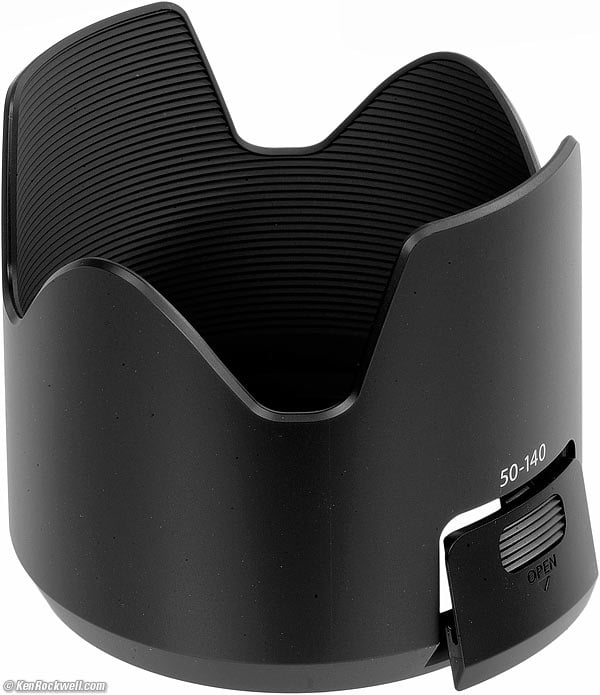
Fuji 50-140mm hood (included).
Plastic bayonet-mount hood included.
There's a pop-out and easily lost little cover that lets you try to fiddle with a rotating polarizer or grad.
OIS Image Stabilization
Rated 5 stops improvement.
Size
3.26" diameter x 6.93" long.
82.9 mm diameter x 175.9 mm long.
Weight
38.555 oz. (1,093.1g) measured, lens with tripod foot.
34.820 oz. (987.1g) measured, lens only.
Fuji specifies 35.1 oz. (995g) without the foot.
Environment
Rated for use down to -10º C (14º F).
Sealed against weather and dust.
Announced
10 September 2014.
Included
Lens.
Hood.
Front and rear caps.
"Lens wrapping cloth."
Paperwork.
Packaging
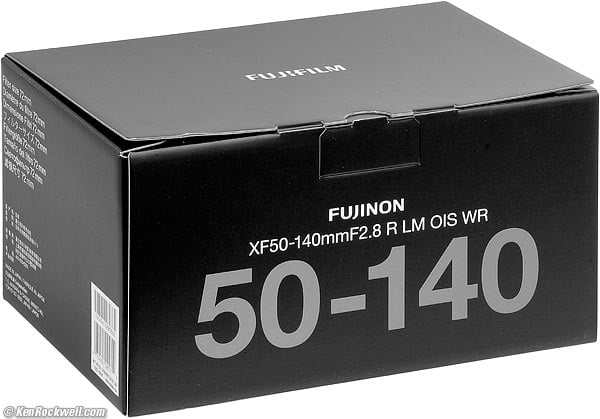
Box, Fuji XF 50-140mm OIS WR.
Inside the micro-corrugated cardboard box are pulp-formed cardboard holders for the plastic-wrapped lens and hood. A small folded tray of microcorrugated cardboard lies on top to hold the manual and lens wrapping cloth.
Price
$1,599, September 2014 ~ January 2015.
Performance top
Intro Specs Performance Usage Recommendations More
Overall Auto and Manual Focus Bokeh Distortion
Ergonomics Falloff Filters Flare & Ghosts Color Fringes
Macro Mechanics OIS Stabilizer Sharpness Sunstars
Overall performance top
The Fuji XF 50-140mm OIS WR is optically close to perfect, and is also very well built. It just replaced the Fuji 55-200mm as the world's best APS-C telephoto zoom.
Auto and Manual Focus performance top
Autofocus is silent, almost instantaneous, and always accurate.
In dimmer light, it's nowhere near as fast as a DSLR with an f/2.8 telephoto. In dim light, it can get lost and not focus. For pro use, DSLRs still focus much faster in every light. This lens works very well in good light, but if you're shooting night sports, forget about it.
You have to move a switch on your camera to go between auto and manual focus.
Manual focus is by-wire, meaning the manual focus ring is merely an encoder that talks to a computer that moves the lens. Manual focus is precise for best results on a tripod; it's not fast enough for live subjects. See Usage for how to use it quickly.
Bokeh performance top
Bokeh, the softness of out-of-focus areas, not how far out of focus they are, is superb. Regardless of aperture setting, backgrounds don't distract.
Here's a subject at about headshot distance. I'm stepping back each time as I zoom-in to keep about the same sized subject.
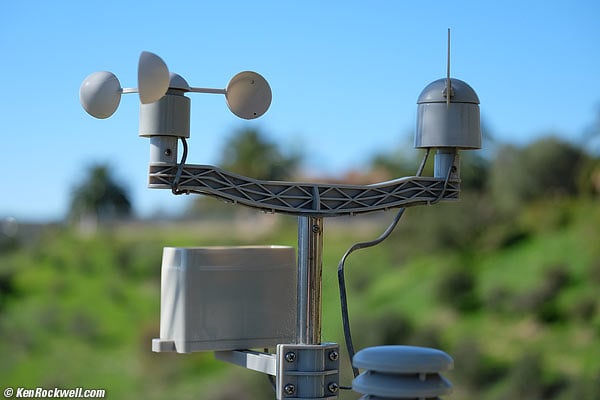
At 50mm and f/2.8.
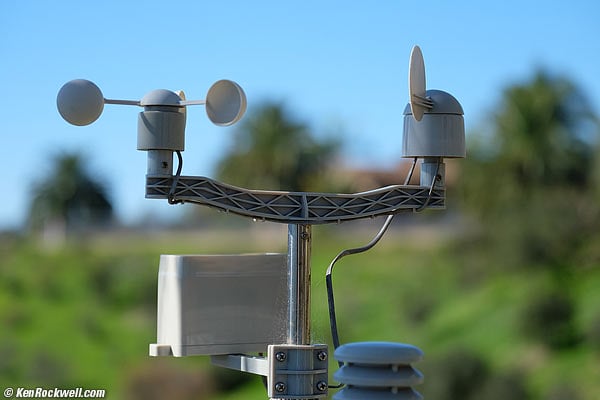
At 70mm and f/2.8.
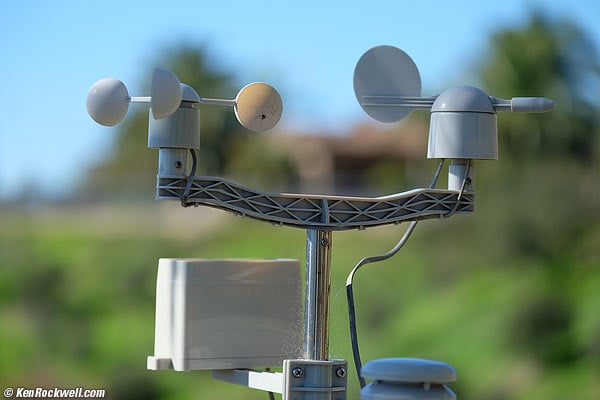
At 90mm and f/2.8.
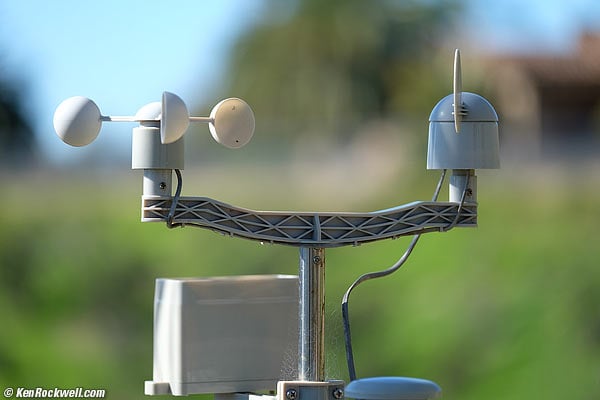
At 140mm and f/2.8.
Distortion performance top
Distortion is completely invisible, at least as shot as JPGs on my Fuji X-E2, which for all I know is correcting it automatically.
What little distortion there is can be corrected for more critical use by plugging these figures into Photoshop's lens distortion filter. These aren't facts or specifications, they are the results of my research that requires hours of photography and calculations on the resulting data.
|
Correction factor at 30' (10m) |
50 mm |
-0.4 |
70 mm |
-0.5 |
90 mm |
-0.5 |
140 mm |
-0.5 |
© 2015 KenRockwell.com. All rights reserved.
Ergonomics performance top
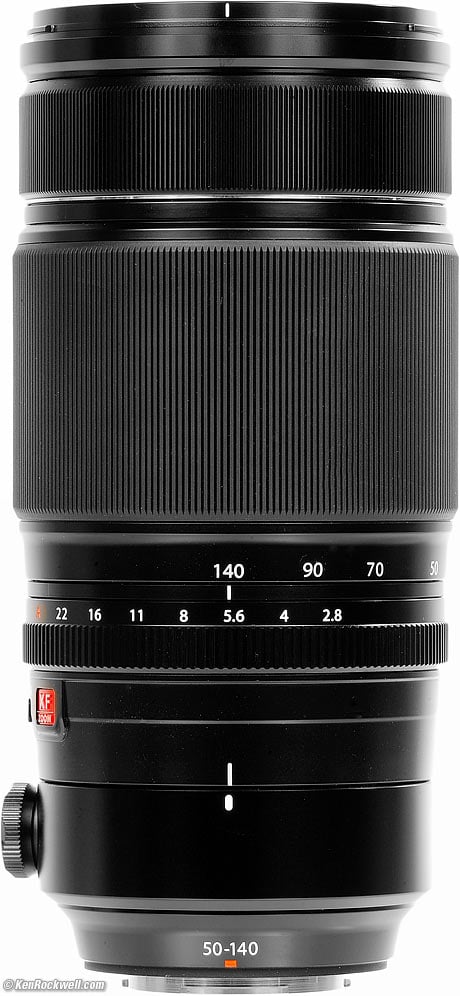
Fuji XF 50-140mm OIS WR for X-mount cameras.
Ergonomics are easy.
It feels great to have a mostly metal lens in my hands. All the other brands of APS-C telephotos are all plastic.
The zoom ring is moderately heavily damped. You'll want to use two fingers to zoom, but it will move with one strong finger.
The aperture ring is huge and has third-stop clicks. Unfortunately the full stops aren't more deeply detented than the thirds. Switch away from A to set an aperture manually.
For the manual focus ring to work, you have to change the setting on your camera. Otherwise the ring is ignored in autofocus. Even in manual focus, the ring is never connected to the lens; it's connected to a computer which in turn moves a motor in the lens to focus.
The manual focus ring is very stiff.
Falloff (darkened corners) performance top
Light falloff is completely invisible even wide open, as shot on the X-E2 which is probably correcting it automatically.
I've exaggerated this by shooting a gray field and placing these on a gray background, and it's still almost invisible:
50-140 2.8 falloff at infinity on Fuji X-E2:
© 2015 KenRockwell.com. All rights reserved.
|
Flare and Ghosts performance top
With 23 elements, it's got more flare and ghosts than most modern tele zooms.
Here's a shot directly into the sun. You won't see anything this bad in actual use, but if you go out of your way to do stupid things like this (pointing a telephoto lens directly into mid-day sun), you'll see flare and ghosts like this:
Flare and ghosts at 50mm at f/8 at 1/420 at ISO 100. bigger.
Filters, Use with performance top
There's no problem with vignetting, even with stacked filters.
Lateral Color Fringes performance top
There are no visible lateral color fringes as shot as JPGs on the X-E2.
Macro performance top
It gets as close as most lenses, nothing special here. The Canon 100-400mm II focuses much closer.
Longines 23ZS at close-focus distance at 140mm. f/9 at 1/350 on X-E2 at ISO 100.
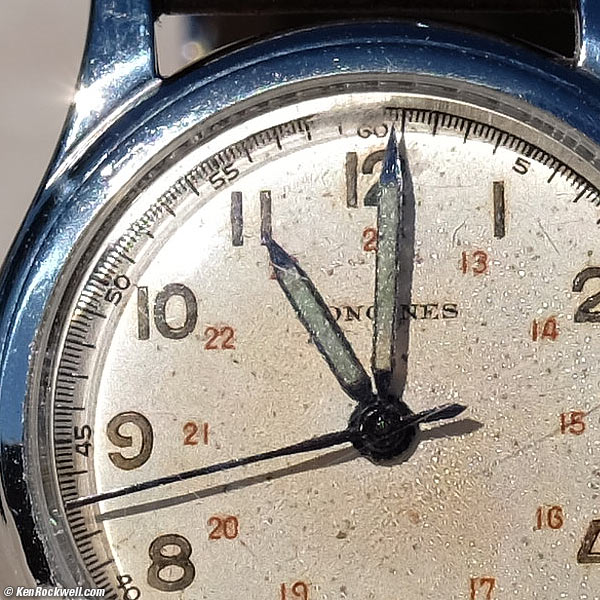
Crop from above image at 100%. If this is about 6" (15cm) on your screen, printing the complete image at this same high magnification would result in a 50 x 30" (125 x 85 cm) print!
This is a 60-year-old wristwatch.
Mechanics performance top
Rear, Fuji X-mount XF 50-140mm OIS WR. bigger.
The Fuji 50-140 2.8 is built much better than any other telephoto APS-C lens.
It's mostly anodized aluminum, not cheesy plastic.
Hood
Plastic bayonet.
Filter Threads
Anodized aluminum.
Hood Bayonet
Anodized aluminum.
Identity Ring
Front ring, laser-engraved.
Focus Ring
Anodized aluminum.
Focus Scale
None.
Infinity Stop
None.
Depth-of-Field Scale
None.
Zoom Ring
Rubber-covered plastic.
Painted focal length markings.
Internals
Look like mostly metal.
Aperture Ring
Anodized aluminum.
Third-stop clicks.
Markings engraved and filled with paint.
Tripod Collar and Foot
Metal.
Rear Barrel
Metal.
Serial Number
Laser engraved on rear of lens barrel near mount.
Mount
Dull-chromed brass.
Gasket at Mount?
Yes
Noises When Shaken
Strong clunking from the uncaged OIS system flopping around.
Made in
Japan.
OIS performance top
Weed Vineyard, 15 January 2015. Fuji X-E2 at ISO 200, 140mm at f/22 at 1/15 second hand-held, Athentech Perfectly Clear. Full-resolution from camera-original JPG.
The stabilizer works extraordinarily well. Fujinon knows stabilizers better than anyone; they make the stabilized binoculars used by NASA, as well as my Techno Stabi 10x40 binoculars I use. My 14 power binoculars give me a stable image, even from small fixed-wing aircraft! I think Fuji's been making stabilized binoculars longer than anyone's made stabilized camera lenses.
The 50-140mm stabilizer works so well that my hand-held shots are sharp at 1/8 second at 140mm, and most are usable at 1/4 second. I'm unsure if everyone will do this well, it helps if you know how to shoot a rifle well.
If you hold your ear close to the lens, it makes a slight whooshing sound as it works.
Sharpness performance top
Warning 1: Image sharpness depends more on you than your lens.
Warning 2: Lens sharpness doesn't mean much to good photographers.
Football on Roof, 15 January 2015. Fuji X-E2, Fuji 50-140mm at 140mm, wide-open at f/2.8 at 1/3,000 at Auto ISO 200. Camera-original file.
The Fuji XF 50-140 is super-sharp at all settings. It's sharp edge to edge at every aperture. Only under the most stringent lab conditions can I see the slightest corner softening at f/2.8 at 140mm. Look at the shot above; even wide-open at f/2.8 and 140mm it's sharp edge-to-edge and has no distortion or falloff. (Of course only the center row is actually in focus.)
If you can't make spectacularly sharp photos with this, you're doing something wrong.
Fuji's MTF ratings confirm this:
Rated MTF:
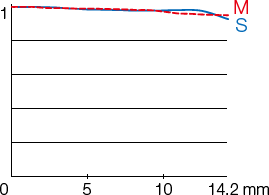 |
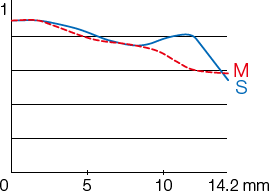 |
50mm MTF at 15 cyc/mm (10 cyc/mm equiv.) |
50mm MTF at 45 cyc/mm (30 cyc/mm equiv.) |
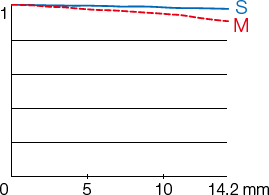 |
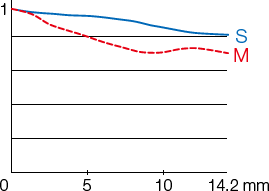 |
140mm MTF at 15 cyc/mm (10 cyc/mm equiv.) |
140mm MTF at 45 cyc/mm (30 cyc/mm equiv.) |
Sunstars performance top
While Fuji claims the 7-blade diaphragm is rounded; it makes great sunstars at all apertures. Of course they are strongest at f/22, while we can get them even at f/5.6:
Sunstars at 80mm at f/5.6. bigger.
Sunstars at 80mm at f/11. bigger.
Sunstars at 80mm at f/22. bigger.
Tripod Collar performance top
Fujinon 50-140mm. bigger.
The tripod collar is smooth and precise. The lock thumbscrew works well, locking tight with only a light touch.
It has no click stops. It does not come off, but you can unscrew the foot.
Usage top
Intro Specs Performance Usage Recommendations More
OIS is the image stabilizer. Leave it on as shown here, except if you're on a tripod for long exposures.
The tripod foot, but not the collar, unscrews. To remove the foot, turn the two screw heads on the foot.
For manual-focus override you have to update your camera firmware and turn AF+MF ON in a menu, and even then it only works while the shutter is half-pressed. It's too slow to be useful.
Forget using the super-slow manual focus ring for manual focus. To focus quickly in manual focus mode, simply tap your camera's AF-L button once, and the camera focuses and locks the distance! Just be careful not to hit the AF-L button again, or of course it will refocus.
Recommendations top
Intro Specs Performance Usage Recommendations More
The Fuji XF 50-140mm OIS WR is the best APS-C telephoto zoom of any brand. It's optically superb, has fantastic image stabilization and is faster and better made than the others.
This is the very best telephoto zoom for the Fuji X-mount cameras. You could adapt LEICA or other lenses to the Fujis, but none will perform as well optically, and none will offer autofocus, EXIF data or diaphragm automation.
I got mine at this link to it at Adorama; these links to it at Amazon and at B&H are also great places to get it.
If you've found my research here helpful, this all-content, junk-free website's biggest source of support is when you use those or any of these links to approved sources when you get anything, regardless of the country in which you live. Fuji does not seal its boxes, so never buy at retail or any source not on my personally approved list since you'll have no way of knowing if you're missing accessories, getting a defective or damaged customer return, store demo or a used product. Buy only from the approved sources I use myself for the best prices, service, return policies and selection. Thanks for your support! Ken.
Thanks!
Ken.
More Information top
Intro Specs Performance Usage Recommendations More
Fuji's 50-140/2.8 press release.
Help me help you top
I support my growing family through this website, as crazy as it might seem.
The biggest help is when you use any of these links when you get anything, regardless of the country in which you live. It costs you nothing, and is this site's, and thus my family's, biggest source of support. These places have the best prices and service, which is why I've used them since before this website existed. I recommend them all personally.
If you find this page as helpful as a book you might have had to buy or a workshop you may have had to take, feel free to help me continue helping everyone.
If you've gotten your gear through one of my links or helped otherwise, you're family. It's great people like you who allow me to keep adding to this site full-time. Thanks!
If you haven't helped yet, please do, and consider helping me with a gift of $5.00.
As this page is copyrighted and formally registered, it is unlawful to make copies, especially in the form of printouts for personal use. If you wish to make a printout for personal use, you are granted one-time permission only if you PayPal me $5.00 per printout or part thereof. Thank you!
Thanks for reading!
Mr. & Mrs. Ken Rockwell, Ryan and Katie.
Home Donate New Search Gallery Reviews How-To Books Links Workshops About Contact


